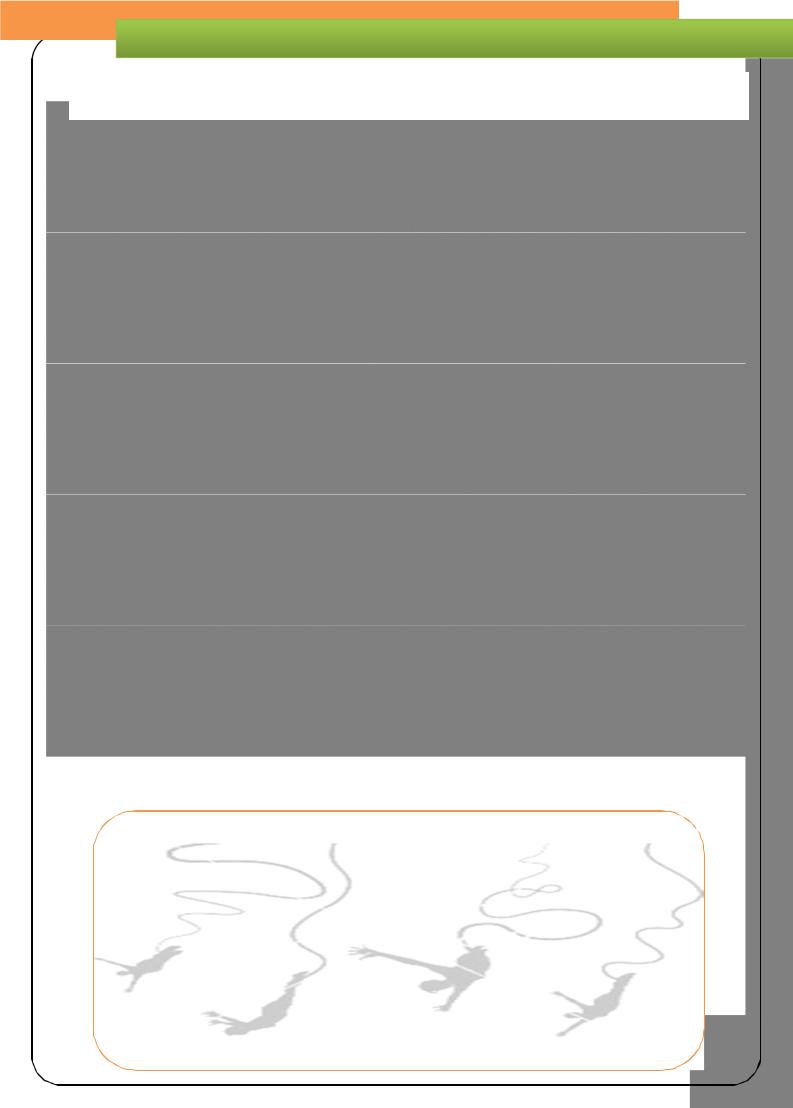
Unit_2
.pdf
Unit 2:
Lesson 1 |
Lead-in |
Taking Risks |
p.31 |
Lesson 2 |
Theme One |
Living on the Edge |
p.36 |
Lesson 3 |
Theme Two |
All Part of the Job |
p.43 |
Lesson 4 |
Brush Up |
|
p.48 |
|
Active Vocabulary |
|
p.53 |

Lead-In: Taking Risks
 Ex. 1 Read an extract from an article about a children’s playground in Japan. What are the main safety measures? What do you think of them?
Ex. 1 Read an extract from an article about a children’s playground in Japan. What are the main safety measures? What do you think of them?
Japan’s children play safe.
When Ryosuke and Taemi Suzuki take their 18-month- daughter to Fantasy Kids Resort in Japan, they are guaranteed total peace of mind. Fantasy Kids Resort is one of several similar playgrounds in Japan that provide for the growing number of parents who constantly worry about possible dangers threatening their children, such as disease and accidents.
First-time visitors to the playground must provide proof identification before they enter, and shoes must be removed at door because they carry germs. Even the wheels of baby carriages sprayed with an antibacterial solution.
Inside, children are watched over by about 20 staff members, dressed in bright yellow uniforms, and more than a dozen security cameras are mounted on the ceiling. Pets are banned from playground, its large sandpit contains sterilized sand that is cleaned
daily to remove any potentially harmful objects. Most of the bigger toys are inflatable to reduce the risk of injury. This is to protect the resort as much as the children because parents of a child injured while at the playgroundmight easily sue the resort.
"We've been here before and we'll definitely come again," says Mr. Suzuki. "This place has everything under one roof, but most importantly, it puts absolute priorityon safety."
Mr. and Mrs. Suzuki are not alone in wanting to remove just about every element of risk from their children's lives. According to a recent government survey...
 Ex. 2 Now listen to an interview with Sue Palmer, director of a preschool in England.
Ex. 2 Now listen to an interview with Sue Palmer, director of a preschool in England.
1. How is her attitude different from that of Mr. and Mrs. Suzuki?
2. Do you agree with Sue’s philosophy about young children and risk?
Unit 2: Student’s Book
31

 Ex. 3 Completeeach sentence withone of the words or phrasesgiven.
Ex. 3 Completeeach sentence withone of the words or phrasesgiven.
|
|
endangered |
|
hazardous |
|
safety |
|
|
death toll |
|
draw straws |
|
the consequences |
|
|
challenge |
|
neglected |
|
claims |
|
|
take achance |
|
thrill |
|
risk |
|
|
daredevil |
|
luckycharm |
|
jeopardy |
|
|
|
|
|
|
|
|
|
|
|
|
|
|
1.The weather looks bad, but I think we'll
…………………. and go for the summit,' said Chris.
2.He'd given too much to his career, worked long hours, …………………. her.
3.On the day that he crashed, Michael had forgotten to take his …………………. a rabbit's foot - with him.
4.EARTHQUAKE …………………. SIXTYLIVES.
5.HUNGERFORDMASSACRE:…………………. 16.
6.Cars can be parked here at the owners'
…………………..
7.Deep-sea fishing is an extremely
…………………. occupation.
8.The future of the race is in ………………….
if the safety record does not improve.
9.The men who rode the motor bikes on the 'Wall of Death' called themselves the
…………………. Riders'.
10.The negligence of the captain
…………………. the lives of the passengers and crew.
11.Speaking from his hospital bed, Nigel said that those, like himself, who engage in dangerous sports just had to accept
…………………. when things went wrong.
12.Gerald found the …………………. of driving at high speed completely irresistible.
13.The expedition will set out tomorrow, to face the …………………. of climbing the last unconquered peak in the Himalayas.
14.The survivors …………………. to decide who should go in search of help. for
…………………. benefit if you own your house.
15.Many employers are becoming more
………………….-conscious.
Answer the following questions using words in italics:
a.What makes people expose themselves to danger?
b.Do you have your good-luck charm? What can be regarded as good-luck charm?
c.What hazardous occupations can you name?
d.In what situations do people usually draw straws or toss a coin?
e.What kind of film, book or incident can thrillthe audience/ people?
f.Why do people start neglecting their families?
g.What do you think of daredevils?
h.Do you believe in lucky charms? Do you have one?
i.What does presently claim most of your time?
j.What’s the most challenging thing in your life now?
32
Unit 2: Student’s Book

 Ex. 4 Complete the text using the words and phrases given.
Ex. 4 Complete the text using the words and phrases given.
warning |
odds |
sheer folly |
chances |
security |
mistaken belief |
run |
hazardous |
charmedlife |
foreseen |
precautions |
peace of mind |
safety-conscious |
safety records |
numbed |
Statistics prove that the ............................ |
(1) of having a serious accident in your own home or car |
|
are relatively high. However, people's perception of the risks they ............................ |
(2) while engaged |
|
in everyday activities is quite low, and this often leads to inexplicable acts of |
............................ (3). |
|
'Familiarity breeds contempt', as the saying goes. People have been known to search for a gas leak using a candle for illumination, for example, or to hold their babies on their laps in the front seat of cars, instead of securing them safely in the rear seat, in the ............................ (4) that they can protect them in the event of a collision. The familiarity of the surroundings lulls people into a false sense of
disturb............................their |
(5), often to such an extent that they do not allow even obvious danger signals to |
|
............................ (6).'I never thought it would happen to me,' is the refrain of those |
||
surprised by dangers that could have been ............................ |
(7) and avoided. However, when it comes |
|
to travel by air or train, people are often extremely anxious about the potential dangers, despite the fact that airlines and railways have excellent ............................ (8), notwithstanding the occasional spectacular crash. The fixed routines necessary for the safe operation of transport systems carry
their own dangers, however. It can happen that drivers and pilots, their brains ............................ |
(9) by |
|
the monotony of repetitive tasks, fail to take notice of ............................ |
(10) lights and signals. |
|
Occasionally, someone, so heedless of his own safety, so desperate |
||
for thrills, or so convinced that he bears a(n) ............................ |
(11), will |
|
play such deadly games as Russian |
Roulette, in which |
even if the |
............................ (12) are six to one, the consequences can be fatal. Such games, whether prompted by bravado or a sort of death wish, cannot be
compared with unavoidably ............................ |
(13) activities such as |
mountain-climbing and deep-sea diving |
where taking ............................ |
(14), not risks, is uppermost in the minds of the participants. The main danger to us all lies in the unexpected accidents of everyday life and it is therefore essential to be alert and ............................ (15) while at home or work.
Discuss the following questions:
1.Where does people’s low perception of the risklead to?
2.How could you explain the saying “Familiarity breeds contempt”? Provide examples.
3.Why do people ignore obvious danger signals? What are they?
4.What could actually disturb people’s peace of mind, make them alert?
5.What might people feel when it comes to travel by plane or train? What could drive away their anxiety?
6.Why are fixed routines potentially dangerous?
7.What make people play such deadly games as Russian Roulette?
8.What are the rules of the game Russian Roulette?
9.What activities cannot avoid hazards?
10.Why cannot such games as Russian Roulette be compared with mountainclimbingor deep-sea diving?
33
Unit 2: Student’s Book

 Ex. 5 Complete the sentences below with forms of the words on the right.
Ex. 5 Complete the sentences below with forms of the words on the right.
|
1. |
After several burglariesin the area, security is now ahigh …………… . |
|
|
PRIOR |
|
2. |
The new current affairs series promises to address…………… issues with |
|
|
|
|
|
CHALLENGE |
|||
|
3. |
freshness and rigour. |
|
|
|
|
|
THRILL |
|||
|
Jon featured in one of the show's most …………… episodes. |
|
|
|
|
|
4. |
She asked Mark to drive…………… . |
|
|
SAFE |
|
5. |
Buying a secondhand car is a…………… business. |
|
|
RISK |
|
6. |
Due to …………… circumstances, the play has been cancelled. |
|
|
FORESEE |
|
7. |
The policy was rejected in favour of a more…………… approach. |
|
|
CAUTION |
|
8. |
She became more and more…………… ofher responsibilities. |
|
|
NEGLECT |
|
9. |
If I went out and accepted a job at a lot less money, I'd…………… a good |
|
|
|
|
|
|
JEOPARDY |
||
|
|
career. |
|
|
|
|
|
|
|
||
 Ex. 6 Comment on the picture.
Ex. 6 Comment on the picture.
Traffic accidents are among the most frequent risks we face in our everyday lives. What are the causes? What precautions can be taken (both on the part of drivers and pedestrians) in order to minimize the risk? Discuss with a partner.
|
|
Active Vocabulary |
|
security |
hazard |
safety (cameras) |
precaution |
priority |
hazardous |
safety-conscious |
charmed life |
to endanger sb |
to draw straws |
safety measures |
peace of mind |
death toll |
life&limb |
risk |
jeopardy |
to challenge |
thrill |
to claim |
to jeopardize |
challenging |
to thrill |
un/foreseen |
to threaten |
to take a chance |
thrilling |
the odds |
a threat |
daredevil |
lucky charm |
consequence |
a warning |
Unit 2: Student’s Book
34

Hometask 1
 Ex. 7 Study the active vocabulary. (Quiz 1)
Ex. 7 Study the active vocabulary. (Quiz 1)
 Ex. 8 Read the text from ex. 13 and write a summary of it (200-250 words).
Ex. 8 Read the text from ex. 13 and write a summary of it (200-250 words).  Ex. 9 You are going to listen to a risk expert talking about the risks of driving in the US. Before you listen, predict which option you think is correct. Then listen and check.
Ex. 9 You are going to listen to a risk expert talking about the risks of driving in the US. Before you listen, predict which option you think is correct. Then listen and check.
1.The most dangerous thing to be on the road is _________.
a.a pedestrian
b.a driver
c.a motorcyclist
2.Most accidents happen because drivers _________.
a.fall asleep at the wheel
b.are drunk
c.drive too fast
3.Driving at night is _________ as dangerous as driving during the day.
a.three times
b.four times
c.ten times
4.You are most likely to have a nonfatal accident on a _________.
a.Tuesday morning
b.Friday afternoon
c.Saturday night
5.Most fatal accidents happen on _________.
a.highways
b.freeways
c.country roads
6.Mile for mile, women have more _________ than men.
a.minor accidents
b.serious accidents
c.fatal accidents
7.The age at which a driver is most at risk is _________.
a.over 65
b.between 25 and 34
c.under 25
Would these statistics probably be similar in your country?
Do you think punishments for dangerous driving should be more severe?
 Ex. 10 Translate into Russian using the active vocabulary.
Ex. 10 Translate into Russian using the active vocabulary.
1) После теракта 2001 г. власти приняли ряд мер, призванных обеспечить безопасность горожан и сократить риск повторных атак. 2) Не желая подвергать опасности жизни спортсменов, организаторы решили не рисковать и приняли повышенные меры предосторожности. 3) Наводнение имело страшные последствия: сотни поврежденных домов,
разрушенная инфраструктура, не говоря уже о человеческих жертвах. В списках погибших значатся 220 человек, еще 32 считаются без вести пропавшими. 4) В магазине установлены камеры безопасности, предназначенные не только предотвратить кражи, но и обеспечить
безопасность посетителей. 5) Я считаю его поступок глупым, не было никакой необходимости так рисковать. Теперь под угрозой его карьера и будущее. 6) Он настоящий сорви-голова: риск -
это его стихия. Он каким-то чудом остается цел и невредим, какие бы опасности его встречали. Ему нравится бороться сам собой. В этом длянего "кайф".
35
Unit 2: Student’s Book

Theme One: Living on the Edge
 Ex. 11 Write Quiz 1, check ex. 7-10. Abrief recap of the previouslesson.
Ex. 11 Write Quiz 1, check ex. 7-10. Abrief recap of the previouslesson.
 Ex. 12 What is happening ineach of the photographs. Discuss.
Ex. 12 What is happening ineach of the photographs. Discuss.
1.Do any of these activitiesappealto you? Why/why not?
2.Which activity do you think is the most exciting/popular/risky?
3.What is the attraction of extreme sportscompared with activities such as computer games or reading?
|
USEFUL LANGUAGE |
|
Topical |
|
Clichés |
go in for extreme sports |
exciting |
In the picture we can see… |
to run the risk of … |
thrilling |
I am convinced that… |
to enjoy sth |
appealing |
As for me… |
to be keen on sth |
risky |
Personally… |
to be fond of sth |
hazardous |
I am for/against… |
to challenge oneself |
fun |
From my experience… |
to endanger one’s life |
irresponsible |
I disapprove of… |
to appeal to sb |
sheer folly |
To be frank… |
36
Unit 2: Student’s Book

 Ex. 13 Before reading, match the words and phrases listed below to their Russian equivalents.
Ex. 13 Before reading, match the words and phrases listed below to their Russian equivalents.
1. |
general public |
a. |
наполнять жизнь, делать ее яркой |
|
|
||
b. |
долго, подробно, детально |
||
2. |
be a burden to |
c. |
поиск острыхощущений |
3. |
at great length |
|
|
d. |
раздвигать границы/превысить порог |
||
4. |
find outlets for |
e. |
приятное возбуждение; опьянение; радость |
5. |
to be a fulfillingpart of sb’s life |
|
|
f. |
запрограммированный, врожденный |
||
6. |
to crave adventure |
g. |
соблюдающий правила безопасности |
7. |
to play on the edge |
|
|
h. |
найти выход чему-л. (напр. гневу, эмоциям) |
||
8. |
thrill seeking/ sensation seeking |
i. |
широкая публика; общественность |
9. |
safety conscious |
|
|
j. |
жаждать чего-л. |
||
10.to be hardwired |
|
|
|
k. |
действовать на грани |
||
11.exhilaration |
|
|
|
l. |
быть ношей, обузой |
||
12.push the limits |
|
|
|
 Ex. 14 Read the text.
Ex. 14 Read the text.
Living on the Edge: Extreme Sports and theirRole in Society1
With regard to extreme sports, the perception of the general public is that people who choose to take risks are irresponsible ‘adrenaline junkies’ who are ultimately a burden to society. When a person takes unnecessary risks, and becomes injured or in need of rescue, the expenses for coming to their aid are often borne by taxpayers. It should not be surprising then, that these same taxpayers question why they should have to pay for these seemingly foolish actions. A backcountry rescue after skiers trigger an avalanche, for example, will cost thousands of dollars. Skateboarders cause damage to both private and public property, and injure themselves. While these issues have been discussed at great length in the media, rarely does discussion focus on the negative impact of limiting access to these types of risky sports. What would be the effect on society if we made it more difficult for people to engage in these types of activities? In fact, by curbing a person’s passions and limiting access to their chosen sports–even those the public may consider risky– these athletes may well find outlets for their energy that is much more burdensome to society.
While it is true that extreme sports do not appeal to the masses, there are still a significant number of people to whom these activities are an important and fulfilling part of their lives. It is our differences that make a society interesting, so while it may not be for everyone, high-risk activities contribute to the diversity of our culture. We all crave adventure to some degree or another. As author, outdoorsman, and Idaho State University faculty member, Ron Watters explains in his essay “The Wrong Side of the Thin Edge”, everyone needs a little adventure. But some people need more than the normal forms of life’s excitement and take it one step further, participating in high-risk activitiessports played on the edge, where the consequences are far greater, and where as the great American mountaineer and outdoor philosopher Willi Unsoeld once said, ‘It has to be real enough to kill you.’ (258) Psychologist Frank Farley has studied thrill seeking risk-takers for decades, and has developed the term “Type T” (for thrill seeking). Farley describes Type T personality types as "risk-takers and adventurers who seek excitement and stimulation wherever they can find or create it." (qtd. in Roberts)
Type T’s are not just the mountain climbing daredevils of the world however. They are often our best inventors, entrepreneurs and explorers. They are CEOs, surgeons, and civil rights leaders. We wouldn’t be the progressive, vibrant society we are today if no one was willing to take risks. Farley argues that history's most crucial events are shaped by Type T individuals exhibiting Type T behavior, from Boris Yeltsin to Martin Luther King, Jr. The act of emigration, he says, is an intrinsically risky endeavor that selects individuals who are high in sensation seeking. Consequently, countries built upon immigrant population--America, Canada, Australia--probably have an above-average level of risk takers. He warns
1 |
from http://www.summitpost.org/living-on-the-edge-extreme-sports-and-their-role-in-society/214107 |
37 |
|
Unit 2: Student’s Book

that much of the current effort to minimize risk and risk taking itself runs the risk of eliminating "a large part of what made this country great in the first place." (qtd. in Roberts)
But for all their positive attributes, Type T personalities also have a dark side. They often bore easily, and without other options their craving for stimulation can lead them to abuse drugs and alcohol, gamble, or engage in other destructive behaviors. People who engage in extreme sports do take risks, but there are far more dangerous ‘highs’ they could be seeking. Rock climbing, mountain biking and snowboarding offer a high that can only be achieved through self discipline, hard work, and a healthy lifestyle. People who are serious about extreme sports are highly trained athletes who take care of their bodies and tend to be very safety conscious.
There is evidence to show that the Type T personality is something people are born with. It isn’t a lifestyle choice. In fact risk taking has been linked to levels of dopamine, a chemical found in the brain that regulates mood and pleasure. The predisposition to risk-taking is not a new genetic development. It is likely hardwired into our evolutionary makeup from ancient times, when our survival depended upon the ability to hunt and defend ourselves from attack from predators or other humans. We have been successful in eliminating the vast majority of risk from our daily lives: seatbelts, airbags, and other safety advancements have greatly reduced the dangers associated with driving a car. Most people wear helmets when they bike and rollerblade. Coffee cups even warn us now that the beverage we are about to enjoy is extremely hot. As Watters explains:
The world has become far too safe, and heretofore unknown lands are mapped in far too much detail. As a consequence, we need as many outlets as possible for people to participate in challenging outdoor activities. We need wilderness lands; we need rock climbing areas; we need wild rivers; we need outdoor schools, and given proper environmental safeguards, we need free and unfettered access to outdoor areas. The right to risk is unalienable. It makes our society healthier and more vibrant. (259)
It is getting increasingly difficult to take any risks in the course of a day, and yet we still have this innate need for exhilaration. Without relatively safe outlets for this drive, people predisposed to risk taking behaviors will seek out other activities, with potentially greater personal, social, and economic consequences.
Instead of shunning and discouraging extreme athletes, we should celebrate them for their differences and do what we can to support them as they climb higher, go faster and push the limits of human endurance and athleticism. As T.S. Elliot once said, “Only those who will risk going too far can possibly find out how far one can go.” With public support, extreme athletes can expand our boundaries and contribute to our diverse and evolving society. By curbing their passions and limiting access to activities some consider too dangerous, we may be inviting even greater risk in the form of addictions, crime and health problems the end result of which is a heavy burden for society to bear.
 Ex. 15 Answer the teacher’s questions.
Ex. 15 Answer the teacher’s questions.
 Ex. 16 Discuss. Use the active vocabulary from the box below.
Ex. 16 Discuss. Use the active vocabulary from the box below.
1. |
Do extreme sports |
appeal to |
you? Why? Why not? |
|
|
||||||
2. |
Do you agree that all people |
crave |
adventure? Are you adventurous? What adventure do you |
Book |
|||||||
|
|
||||||||||
3. |
crave to |
engage in |
? |
|
contribute considerably to |
the progress of society? Provide |
|
||||
Do you agree that thrill seekers |
|
|
2:Student’s |
||||||||
|
than |
|
|
? |
|
|
|
|
|
|
|
4. |
examples. |
challenging activities |
|
|
|||||||
Do you enjoy |
|
|
|
|
|
? What type? |
|
|
|||
5. |
Do you agree with the author’s conclusion thatextreme athletes should be supported rather |
|
|||||||||
|
|
discouraged |
|
|
|
|
|
|
|
||
|
|
|
|
|
|
|
|
|
|
|
Unit |
38

 Ex. 17 Translatethe following wordsand word combinations into Russian.
Ex. 17 Translatethe following wordsand word combinations into Russian.
to take risks
to bear expenses
to cause damage to
to have effect on
to engage in
to appeal to the masses
to contribute to the diversity of our culture 
to seek excitement
a daredevil
history's most crucial events are shaped by Type T individuals
tend to be very safety conscious
challengingoutdoor activities
Ex. 18 Observe the |
table and translatethe sentences below into Russian. |
||||
|
|
|
|
|
|
|
verbs |
adjectives |
compounds |
derivates |
|
|
|
to take |
great |
risk-taker |
risky sth |
|
|
||||
|
|
to run |
huge |
risk-taking |
to risk |
|
|
to reduce |
unnecessary |
risk-aversion |
sth |
|
|
to avoid |
foolish |
high-risk |
or doing |
|
|
to seek |
calculated |
risk expert |
|
|
|
to minimize |
|
risk |
|
|
|
to eliminate |
|
management |
|
1.If a woman gives up her job to look after her baby, she will risk losing her salaryin the mediumterm and may seriously damage her long-term career prospects.
2.Fair-skinned people who spend a great deal of time in the sun have the greatest risk of skin cancer.
3.In this new world of greyness there is an attempt to remove all risks.
4.‘I have never knowingly exposed any patient to unnecessary risks,’ he said.
5.The officers had run the risk of being dismissed.
6.The recues were able to evacuate 500 children who were at risk.
7.Skiers always face the risk of serious injury.
8.All personal belongings are left at the owner’s risk.
9.This diet could reduce your risk of certain cancers.
10.They are anxiousto avoid any risk of criticism.
11.Investments that provide a high returngenerallyinvolve more risk.
 Ex. 19 You are going tolisten to an extract from a radio programme. Before
Ex. 19 You are going tolisten to an extract from a radio programme. Before
listening, match the words and phrases listed below totheir Russian equivalents.
1. |
a ban on sth |
a. |
любить что-л. |
2. |
remote slope |
b. |
сплав по (бурной) реке |
3. |
a prime example |
c. |
отдаленный склон, спуск |
4. |
fancy doing sth |
d. |
запрет на что-л. |
5. |
white-water rafting |
e. |
лавина |
6. |
paragliding |
f. |
парапланеризм |
7. |
avalanche |
g. |
яркий, показательный пример |
39
Unit 2: Student’s Book
